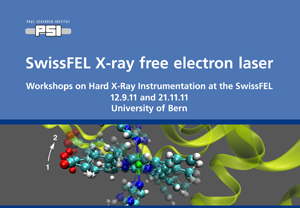Speaker
Dr
Cedric Cozzo
(Paul Scherrer Institut)
Description
In the PINE project, nuclear fuel microspheres are obtained by microwave internal gelation (MIG) [1, 2]. Free falling droplets, containing chemical ingredients (feed solution), undergo a precipitation (gelation) induced by microwave heating. The reaction is triggered by decomposing a reactant at a given temperature. However, literature suggests that microwaves could also have a nonthermal catalityc effect on chemical reactions [3, 4, 5]. In order to understand and improve the process, the degree of gelation advancement inside the falling droplet needs to be determined. This can be done thanks to a XAS measurement of droplets at different gelation states. An experiment at the SuperXAS beamline (PSI) has proven that falling drops could be detected and analysed.
The high time resolution of the swissFEL allows the determination of effects faster than thermalisation (thermalisation time ~1 ps), for example by single shot (pulse length 13-16 fs) EXAFS (XANES) spectra on the metal absorber (cerium). The possibility to extract whole spectra from single exposures also allows to perform above experiment (at SuperXAS) on single droplets, and provides much better spectra, as changing droplet characteristics are omitted. Using a beam splitter, or delay lines based on diffractive X-ray optics (idea by C. David [6], PSI LMN), a multiple pulse (ideally 4 to 10) can be produced in the time range of a microwave period (100 ps at 10 GHz). This tool provides a temporal mapping of the surrounding species and resolves the influence of the EM electro-magnetic field on their interaction. It will provide essential information on the nonthermal microwave enhancement of chemical reactions.
[1] M. Pouchon and collaborators. Pine - platform for innovative nuclear fuels. Technical report, CCEM, Annual activity reports 2009, 35-36.
[2] M.A. Pouchon and collaborators. Pine - platform for innovative nuclear fuels. Technical report, CCEM, Annual activity reports 2010, 42-44.
[3] J. Berlan. Microwaves in chemistry: another way of heating reaction mixtures. Radiat. Phys. Chem., 45:581–589, 1995.
[4] J.H. Booske, R.F. Cooper, and S.A. Freeman. Microwave enhanced reaction kinetics and ceramics.pdf. Mat. Res. Innovat., 1:77–84, 1997.
[5] B. Toukoniitty, J.-P. Mikkola, D. Y. Murzin, and T. Salmi. Utilization of electromagnetic and accoustic irradiation in enhancing heterogeneous catalytic reactions. Applied Catalysis A, 279:1–22, 2005.
[6] C. David. PSI-XFEL Workshop, Villigen, February 26-27, 2009.
Author
Dr
Cedric Cozzo
(Paul Scherrer Institut)
Co-authors
Dr
Manuel A. Pouchon
(Paul Scherrer Institut)
Ms
Maria Cabanes-Sempere
(Paul Scherrer Institut)
Dr
Nicula Radu
(EMPA)
Dr
Sebastien Vaucher
(EMPA)

